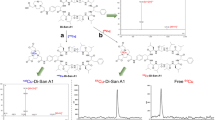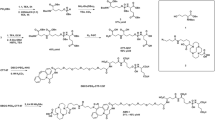Abstract
Purpose
The aim of this study is to non-invasively monitor the epidermal growth factor receptor (EGFR) response to a Hsp90 inhibitor–17-AAG treatment in a PC-3 prostate cancer model.
Procedures
Nude mice bearing PC-3 tumor were injected intraperitoneally with 17-AAG and then imaged with micro positron emission tomography (microPET) using 64Cu-DOTA–cetuximab. Biodistribution studies, immunofluorescence staining, and Western blot were performed to validate the microPET results.
Results
PC-3 cells are sensitive to 17-AAG treatment in a dose-dependent manner. Quantitative microPET showed that 64Cu-DOTA–cetuximab has prominent tumor activity accumulation in untreated tumors (14.6 ± 2.6%ID/g) but significantly lower uptake in 17-AAG-treated tumors (8.9 ± 1.6% ID/g) at 24 h post-injection. Both immunofluorescence staining and Western blot confirmed the significantly lower EGFR expression level in the tumor tissue upon 17-AAG treatment.
Conclusions
The early response to anti-Hsp90 therapy was successfully monitored by quantitative PET using 64Cu-DOTA–cetuximab, which indicates that this approach may be valuable in monitoring the therapeutic response to Hsp90 inhibitor 17-AAG in EGFR-positive cancer patients.




Similar content being viewed by others
References
Arteaga C (2003) Targeting HER1/EGFR: a molecular approach to cancer therapy. Semin Oncol 30:3–14
Schlessinger J (2000) Cell signaling by receptor tyrosine kinases. Cell 103:211–225
Salomon DS, Brandt R, Ciardiello F, Normanno N (1995) Epidermal growth factor-related peptides and their receptors in human malignancies. Crit Rev Oncol Hematol 19:183–232
Raymond E, Faivre S, Armand JP (2000) Epidermal growth factor receptor tyrosine kinase as a target for anticancer therapy. Drugs 60:15–23
Veale D, Kerr N, Gibson GJ, Kelly PJ, Harris AL (1993) The relationship of quantitative epidermal growth factor receptor expression in non-small cell lung cancer to long term survival. Br J Cancer 68:162–165
Raymond E, Faivre S, Armand JP (2000) Epidermal growth factor receptor tyrosine kinase as a target for anticancer therapy. Drugs 60:15–23 (discussion 41)
Veale D, Kerr N, Gibson GJ, Kelly PJ, Harris AL (1993) The relationship of quantitative epidermal growth factor receptor expression in non-small cell lung cancer to long-term survival. Br J cancer 68:162–165
Gross ME, Shazer RL, Agus DB (2004) Targeting the HER-kinase axis in cancer. Semin Oncol 31:9–20
Ranson M, Sliwkowski MX (2002) Perspectives on anti-HER monoclonal antibodies. Oncology 63:17–24
Soulieres D, Senzer NN, Vokes EE, Hidalgo M, Agarwala SS, Siu LL (2004) Multicenter phase II study of erlotinib, an oral epidermal growth factor receptor tyrosine kinase inhibitor, in patients with recurrent or metastatic squamous cell cancer of the head and neck. J Clin Oncol 22:77–85
McManus DT, Patterson AH, Maxwell P, Humphreys MW, Anderson NH (1999) Fluorescence in situ hybridisation detection of erbB2 amplification in breast cancer fine needle aspirates. Mol Pathol 52:75–77
Stomper PC, Budnick RM, Stewart CC (2000) Use of specimen mammography-guided FNA (fine-needle aspirates) for flow cytometric multiple marker analysis and immunophenotyping in breast cancer. Cytometry 42:165–173
Weiner RE, Sasso DE, Gionfriddo MA, Syrbu SI, Smilowitz HM, Vento J, Thrall RS (1998) Early detection of bleomycin-induced lung injury in rat using indium-111-labeled antibody directed against intercellular adhesion molecule-1. J Nucl Med 39:723–728
Niu G, Cai W, Chen X (2008) Molecular imaging of human epidermal growth factor receptor 2 (HER-2) expression. Front Biosci 13:790–805
Cai W, Chen K, He L, Cao Q, Koong A, Chen X (2007) Quantitative PET of EGFR expression in xenograft-bearing mice using 64Cu-labeled cetuximab, a chimeric anti-EGFR monoclonal antibody. Eur J Nucl Med Mol Imaging 34:850–858
Ciardiello F, Damiano V, Bianco R et al. (1996) Antitumor activity of combined blockade of epidermal growth factor receptor and protein kinase A. J Natl Cancer Inst 88:1770–1776
Solit DB, Zheng FF, Drobnjak M et al. (2002) 17-Allylamino-17-demethoxygeldanamycin induces the degradation of androgen receptor and HER-2/neu and inhibits the growth of prostate cancer xenografts. Clin Cancer Res 8:986–993
Basso AD, Solit DB, Munster PN, Rosen N (2002) Ansamycin antibiotics inhibit Akt activation and cyclin D expression in breast cancer cells that overexpress HER2. Oncogene 21:1159–1166
Pratt WB, Toft DO (2003) Regulation of signaling protein function and trafficking by the hsp90/hsp70-based chaperone machinery. Exp Biol Med (Maywood) 228:111–133
Barzilay E, Ben-Califa N, Supino-Rosin L, Kashman Y, Hirschberg K, Elazar Z, Neumann D (2004) Geldanamycin-associated inhibition of intracellular trafficking is attributed to a co-purified activity. J Biol Chem 279:6847–6852
Lang SA, Klein D, Moser C et al. (2007) Inhibition of heat shock protein 90 impairs epidermal growth factor-mediated signaling in gastric cancer cells and reduces tumor growth and vascularization in vivo. Mol Cancer Ther 6:1123–1132
Sepp-Lorenzino L, Ma Z, Lebwohl DE, Vinitsky A, Rosen N (1995) Herbimycin A induces the 20 S proteasome- and ubiquitin-dependent degradation of receptor tyrosine kinases. J Biol Chem 270:16580–16587
Kelland LR, Sharp SY, Rogers PM, Myers TG, Workman P (1999) DT-Diaphorase expression and tumor cell sensitivity to 17-allylamino, 17-demethoxygeldanamycin, an inhibitor of heat shock protein 90. J Natl Cancer Inst 91:1940–1949
Solit DB, Rosen N (2006) Hsp90: a novel target for cancer therapy. Curr Top Med Chem 6:1205–1214
Smith-Jones PM, Solit DB, Akhurst T, Afroze F, Rosen N, Larson SM (2004) Imaging the pharmacodynamics of HER2 degradation in response to Hsp90 inhibitors. Nat Biotechnol 22:701–706
Smith-Jones PM, Solit D, Afroze F, Rosen N, Larson SM (2006) Early tumor response to Hsp90 therapy using HER2 PET: comparison with 18F-FDG PET. J Nucl Med 47:793–796
Cai W, Chen K, Mohamedali KA, Cao Q, Gambhir SS, Rosenblum MG, Chen X (2006) PET of vascular endothelial growth factor receptor expression. J Nucl Med 47:2048–2056
Yang S, Qu S, Perez-Tores M, Sawai A, Rosen N, Solit DB, Arteaga CL (2006) Association with HSP90 inhibits Cbl-mediated down-regulation of mutant epidermal growth factor receptors. Cancer Res 66:6990–6997
Murakami Y, Mizuno S, Uehara Y (1994) Accelerated degradation of 160 kDa epidermal growth factor (EGF) receptor precursor by the tyrosine kinase inhibitor herbimycin A in the endoplasmic reticulum of A431 human epidermoid carcinoma cells. Biochem J 301:63–68
Sakagami M, Morrison P, Welch WJ (1999) Benzoquinoid ansamycins (herbimycin A and geldanamycin) interfere with the maturation of growth factor receptor tyrosine kinases. Cell Stress Chaperones 4:19–28
Citri A, Alroy I, Lavi S et al. (2002) Drug-induced ubiquitylation and degradation of ErbB receptor tyrosine kinases: implications for cancer therapy. EMBO J 21:2407–2417
Orlova A, Tolmachev V, Pehrson R et al. (2007) Synthetic affibody molecules: a novel class of affinity ligands for molecular imaging of HER2-expressing malignant tumors. Cancer Res 67:2178–2186
Cai W, Wu Y, Chen K, Cao Q, Tice DA, Chen X (2006) In vitro and in vivo characterization of 64Cu-labeled AbegrinTM, a humanized monoclonal antibody against integrin avb3. Cancer Res 66:9673–9681
Weiner RE, Sasso DE, Gionfriddo MA, Syrbu SI, Smilowitz HM, Vento J, Thrall RS (1998) Early detection of bleomycin-induced lung injury in rat using indium-111-labeled antibody directed against intercellular adhesion molecule-1. J Nucl Med 39:723–728
Cai W, Ebrahimnejad A, Chen K, Cao Q, Li ZB, Tice DA, Chen X (2007) Quantitative radioimmunoPET imaging of EphA2 in tumour-bearing mice. Eur J Nucl Med Mol Imaging (in press)
van Gog FB, Visser GWM, Klok R, van der Schors R, Snow GB, van Dongen GAMS (1996) Monoclonal antibodies labeled with rhenium-186 using the MAG3 chelate: relationship between the number of chelated groups and biodistribution characteristics. J Nucl Med 37:352–362
Liu Z, Cai W, He L, Nakayama N, Chen K, Sun X, Chen X, Dai H (2007) In vivo biodistribution and highly efficient tumour targeting of carbon nanotubes in mice. Nature Nanotechnology 2:47–52
Boswell CA, Sun X, Niu W, Weisman GR, Wong EH, Rheingold AL, Anderson CJ (2004) Comparative in vivo stability of copper-64-labeled cross-bridged and conventional tetraazamacrocyclic complexes. J Med Chem 47:1465–1474
Strahl BD, Allis CD (2000) The language of covalent histone modifications. Nature 403:41–45
Johnson CA, White DA, Lavender JS, O’Neill LP, Turner BM (2002) Human class I histone deacetylase complexes show enhanced catalytic activity in the presence of ATP and co-immunoprecipitate with the ATP-dependent chaperone protein Hsp70. J Biol Chem 277:9590–9597
Drummond DC, Noble CO, Kirpotin DB, Guo Z, Scott GK, Benz CC (2005) Clinical development of histone deacetylase inhibitors as anticancer agents. Annu Rev Pharmacol Toxicol 45:495–528
Chinnaiyan P, Varambally S, Tomlins SA, Ray S, Huang S, Chinnaiyan AM, Harari PM (2006) Enhancing the antitumor activity of ErbB blockade with histone deacetylase (HDAC) inhibition. Int J Cancer 118:1041–1050
Yu X, Guo ZS, Marcu MG, Neckers L, Nguyen DM, Chen GA, Schrump DS (2002) Modulation of p53, ErbB1, ErbB2, and Raf-1 expression in lung cancer cells by depsipeptide FR901228. J Natl Cancer Inst 94:504–513
Acknowledgment
This project was financially supported by the National Institute of Biomedical Imaging and Bioengineering (NIBIB; R21 EB001785), National Cancer Institute (NCI; R21 CA102123, P50 CA114747, U54 CA119367, and R24 CA93862), Department of Defense (DOD; W81XWH-04-1-0697, W81XWH-06-1-0665, W81XWH-06-1-0042, and DAMD17-03-1-0143), and a DOD Prostate Cancer Training Award PC073549 (to G. Niu), and a Benedict Cassen Postdoctoral Fellowship from the Education and Research Foundation of the Society of Nuclear Medicine (to W. Cai).
Author information
Authors and Affiliations
Corresponding author
Rights and permissions
About this article
Cite this article
Niu, G., Cai, W., Chen, K. et al. Non-Invasive PET Imaging of EGFR Degradation Induced by a Heat Shock Protein 90 Inhibitor. Mol Imaging Biol 10, 99–106 (2008). https://doi.org/10.1007/s11307-007-0123-2
Received:
Accepted:
Published:
Issue Date:
DOI: https://doi.org/10.1007/s11307-007-0123-2




